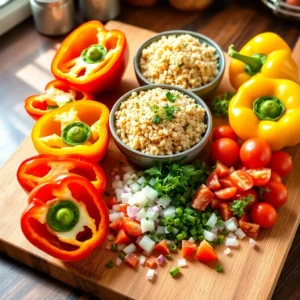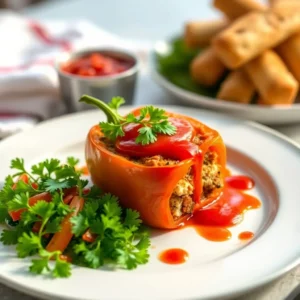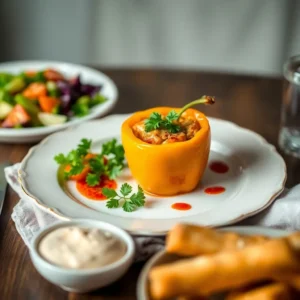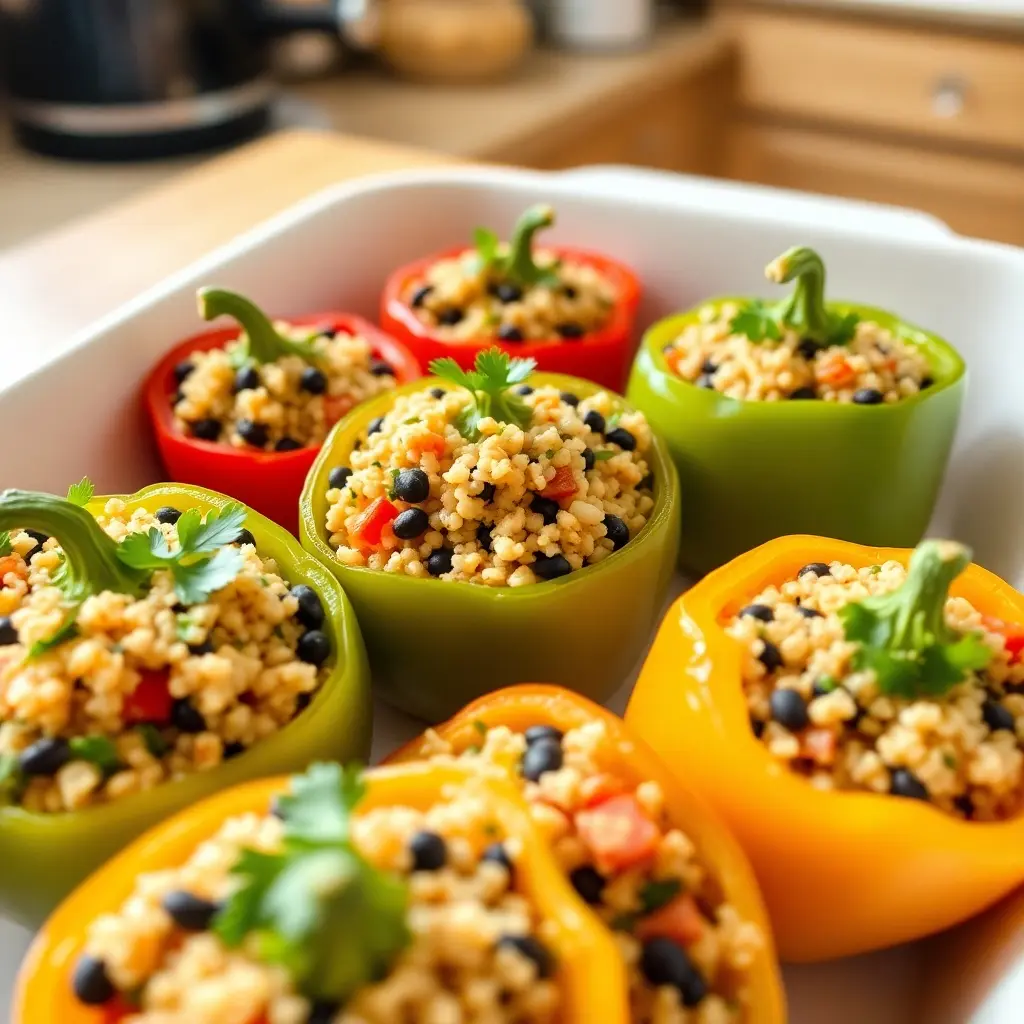There’s nothing quite like the satisfying taste of a hearty, flavorful meal that’s also good for you. This vegan stuffed peppers recipe hits the sweet spot, combining vibrant, nutrient-packed bell peppers with a savory, plant-based filling. It’s a versatile dish you can whip up for a weeknight dinner or dress up for a special occasion. Bursting with colors, textures, and nutrients, these stuffed peppers make plant-based eating a true delight. Let’s dive in and explore every step of creating this delicious meal!
Part 1: Introduction to Vegan Stuffed Peppers
The Popularity of Plant-Based Diets
In recent years, plant-based diets have taken the culinary world by storm, with dishes like vegan stuffed peppers becoming fan favorites. People are drawn to the health benefits, environmental sustainability, and sheer creativity of vegan meals. Whether you’re a seasoned vegan or just dabbling in plant-based eating, this recipe offers something for everyone.
Plant-based meals aren’t just trendy, they’re a celebration of the natural flavors of fresh ingredients. Dishes like these stuffed peppers prove that vegan recipes can be just as comforting and indulgent as their non-vegan counterparts.
Nutritional Benefits of Bell Peppers
Bell peppers, the star of this recipe, are a nutritional powerhouse. Packed with vitamins A and C, antioxidants, and fiber, they provide a refreshing crunch and subtle sweetness that balances beautifully with savory fillings. Not only are they delicious, but they also bring a rainbow of color to your plate, which is always a win!
Overview of the Stuffed Peppers Dish
At its core, a stuffed pepper is all about harmony. The filling—made with grains, legumes, and vegetables—pairs perfectly with the tender, roasted bell peppers. For this vegan stuffed peppers recipe, we’ll keep things simple yet flavorful. Think fluffy quinoa, protein-packed beans, and a medley of colorful veggies, all seasoned to perfection.
Part 2: Ingredients for Vegan Stuffed Peppers
Selection of Bell Peppers
 When choosing bell peppers for your vegan stuffed peppers recipe, opt for those that are firm, vibrant, and free of blemishes. While any color will work, red, yellow, and orange peppers are sweeter and more flavorful compared to their green counterparts. These colors also make your dish visually appealing, which is always a bonus!
When choosing bell peppers for your vegan stuffed peppers recipe, opt for those that are firm, vibrant, and free of blemishes. While any color will work, red, yellow, and orange peppers are sweeter and more flavorful compared to their green counterparts. These colors also make your dish visually appealing, which is always a bonus!
If you want uniform cooking, select peppers that are roughly the same size. This ensures they’ll roast evenly and hold the filling perfectly without collapsing. Don’t forget to wash them thoroughly before you start prepping.
Filling Components: Grains, Legumes, and Vegetables
The filling is where the magic happens. It’s a flavorful combination of grains, legumes, and fresh veggies, all seasoned to create a hearty and satisfying bite. For the grain base, quinoa is a top choice, as it’s light, fluffy, and packed with protein. Alternatively, brown rice or couscous can work just as well if you have them on hand.
Adding legumes like black beans or lentils boosts the dish’s protein content, making it more filling and nutritious. And let’s not overlook the vegetables! Diced tomatoes, onions, zucchini, and corn bring texture and a burst of natural sweetness that complements the peppers beautifully.
Spices and Herbs for Flavor Enhancement
Seasoning is the key to turning good food into great food. For this dish, spices like smoked paprika, cumin, and garlic powder add depth and warmth to the filling. Fresh herbs such as cilantro or parsley not only enhance the flavor but also give the dish a fresh, aromatic finish.
If you’re looking to experiment, try adding a pinch of chili flakes for a touch of heat or a squeeze of lemon juice for a bright, tangy contrast. Spices and herbs are your allies here—don’t be shy to get creative.
With your ingredients prepped, you’re one step closer to creating a delicious plate of vegan stuffed peppers. Let’s move on to putting it all together.
Part 3: Step-by-Step Preparation Guide
Preparing the Bell Peppers
First, you’ll need to prepare your bell peppers so they’re ready to hold the delicious filling. Start by cutting off the tops of the peppers, just below the stems. This creates a nice, open cavity for the stuffing. Remove the seeds and membranes carefully, making sure to keep the peppers intact. After that, rinse them thoroughly to eliminate any leftover seeds.
While prepping, preheat your oven to 375°F (190°C). Placing the peppers upright in a lightly greased baking dish ensures they cook evenly without tipping over. If they don’t stand flat, you can carefully trim the bottoms, but be cautious not to cut through and create holes.
Cooking the Filling
Now comes the fun part—building the flavorful filling. Heat a drizzle of olive oil in a large skillet over medium heat. Add diced onions and minced garlic, sautéing them until fragrant and golden. Next, toss in your diced tomatoes, zucchini, and corn, allowing them to soften slightly.
Once the veggies are tender, stir in cooked quinoa or your preferred grain, along with black beans or lentils. Don’t forget to season generously with smoked paprika, cumin, and a touch of salt and pepper. Stir the mixture thoroughly, letting the flavors meld together for about five minutes. Before you know it, your filling will be bursting with aroma and color, ready to bring your peppers to life.
Assembling and Baking the Stuffed Peppers
With your peppers prepped and the filling ready, it’s time to bring it all together. Gently spoon the filling into each pepper, packing it in snugly but not too tightly. This helps the filling stay in place as the peppers roast. Arrange the stuffed peppers in your baking dish, leaving a bit of space between each one.
Cover the dish with foil to prevent the tops from drying out, then bake in the preheated oven for about 30 minutes. After that, remove the foil and bake for an additional 10-15 minutes, allowing the peppers to become tender and slightly caramelized. The savory filling should be heated through, and the aroma will be irresistible!
Finally, let the stuffed peppers cool slightly before serving. The wait may be tough, but trust me…it’s worth it!
Part 4: Variations and Substitutions
Grain Alternatives: Quinoa, Rice, Barley
 Not everyone has quinoa on hand, and that’s okay! One of the best things about this vegan stuffed peppers recipe is its flexibility. If quinoa isn’t your favorite, you can easily substitute it with other grains. Brown rice, for example, offers a heartier texture and pairs wonderfully with the sweet peppers.
Not everyone has quinoa on hand, and that’s okay! One of the best things about this vegan stuffed peppers recipe is its flexibility. If quinoa isn’t your favorite, you can easily substitute it with other grains. Brown rice, for example, offers a heartier texture and pairs wonderfully with the sweet peppers.
Barley, on the other hand, adds a nutty flavor, though it takes a bit longer to cook. For a quicker option, you might consider couscous, which absorbs flavors beautifully. Each of these grains brings its own unique character to the dish, so don’t be afraid to experiment based on what you love—or what’s already in your pantry.
Protein Options: Tofu, Lentils, Beans
While black beans or lentils are a classic choice, there are plenty of other protein-packed options to explore. Firm tofu, crumbled and sautéed with spices, can make a satisfying and protein-rich addition. Chickpeas are another fantastic alternative, adding a slightly nutty flavor and a pleasant bite to the filling.
If you prefer something heartier, consider using a combination of beans and grains. For instance, mixing chickpeas with couscous or lentils with barley creates a filling that’s both rich and nutritious. No matter what you choose, your stuffed peppers will be deliciously satisfying.
Flavor Profiles: Mediterranean, Mexican, Italian
It’s amazing how a few tweaks to the seasoning can transform this dish into something entirely new. For a Mediterranean twist, try incorporating sun-dried tomatoes, olives, and fresh basil into your filling. You could even drizzle a bit of tahini sauce over the roasted peppers before serving for extra flair.
If you’re in the mood for something spicier, go the Mexican route by adding chili powder, jalapeños, and a sprinkle of vegan cheese. For a comforting Italian version, mix in marinara sauce, oregano, and plant-based Parmesan. Each variation brings its own flair, making this recipe one you’ll never tire of.
Part 5: Serving Suggestions and Pairings
Complementary Side Dishes
 While these vegan stuffed peppers are a complete meal on their own, pairing them with the right side dishes can elevate your dining experience. A crisp green salad, dressed with a light vinaigrette, is a classic choice that adds a refreshing contrast to the hearty peppers. For something a bit more indulgent, try roasted sweet potatoes or a side of herbed couscous.
While these vegan stuffed peppers are a complete meal on their own, pairing them with the right side dishes can elevate your dining experience. A crisp green salad, dressed with a light vinaigrette, is a classic choice that adds a refreshing contrast to the hearty peppers. For something a bit more indulgent, try roasted sweet potatoes or a side of herbed couscous.
Bread lovers might enjoy serving the peppers with a slice of warm, crusty bread to soak up any juices left on the plate. Not only does this enhance the meal, but it also makes every bite feel like a special treat.
Suitable Sauces and Toppings
The right sauce or topping can take your dish from tasty to unforgettable. A drizzle of tangy tomato sauce over the stuffed peppers is a simple yet effective way to enhance their flavor. Alternatively, a dollop of vegan sour cream or a sprinkle of nutritional yeast adds creaminess and a cheesy kick.
If you’re feeling adventurous, a zesty cilantro-lime dressing or a spicy chipotle sauce can add a whole new layer of flavor. For added freshness, don’t hesitate to garnish with chopped parsley or cilantro right before serving.
Presentation Tips for an Appealing Meal
As they say, we eat with our eyes first! To make your stuffed peppers look as good as they taste, arrange them neatly on a large serving platter. Use peppers of different colors to create a vibrant, visually appealing presentation.
Adding a sprinkle of fresh herbs over the top not only boosts the aroma but also makes the dish look more polished. If you’re serving them individually, place each pepper on a plate alongside your chosen sides, ensuring the plate looks balanced and inviting.
Part 6: Nutritional Information and Considerations
Caloric Content
These vegan stuffed peppers aren’t just flavorful—they’re also packed with nutrients that align with a health-conscious lifestyle. On average, one stuffed pepper contains approximately 200-300 calories, depending on the specific ingredients you use. For example, quinoa and beans contribute to the dish’s hearty nature without overloading it with calories.
This makes the recipe ideal for those looking to maintain or reduce their caloric intake while still enjoying a satisfying and flavorful meal.
Macronutrient Breakdown
When it comes to macronutrients, this recipe offers a well-balanced profile. Each pepper delivers a healthy mix of carbohydrates, proteins, and fats. The grains and legumes provide complex carbohydrates and plant-based protein, while the small amount of olive oil used in cooking adds a dose of healthy fats.
For an even higher protein boost, consider adding extra beans or lentils to the filling. This simple adjustment ensures the dish remains nutrient-dense without compromising its delicious taste.
Vitamins and Minerals Provided by the Dish
Bell peppers themselves are a powerhouse of vitamins and minerals. Rich in vitamin C, they help boost your immune system and improve skin health. Additionally, the filling—loaded with vegetables like tomatoes and zucchini—offers an array of antioxidants and essential nutrients.
Quinoa, often called a “superfood,” contributes magnesium, iron, and B vitamins, while beans and lentils provide potassium and fiber. Together, these ingredients create a meal that’s not only tasty but also highly nourishing.
Dietary Considerations
This vegan stuffed peppers recipe is naturally gluten-free if you stick to grains like quinoa or rice. For those with allergies, ensure the seasonings and other ingredients you choose are certified gluten-free.
Additionally, the dish is low in saturated fats and free of cholesterol, making it heart-healthy. And because it’s completely plant-based, it’s suitable for a variety of dietary preferences, from vegan to vegetarian, and even those following a low-fat diet.
By focusing on these nutritional benefits, you can feel good about enjoying a meal that’s as healthy as it is flavorful.
Part 7: Frequently Asked Questions (FAQs)
Can I freeze vegan stuffed peppers?
Absolutely! Freezing these vegan stuffed peppers is a fantastic way to save time and reduce food waste. To freeze them, allow the peppers to cool completely after baking. Then, place them in an airtight container or wrap them individually in plastic wrap and foil for added protection.
When you’re ready to eat, thaw the peppers in the refrigerator overnight and reheat them in the oven at 350°F (175°C) until warmed through. Freezing doesn’t compromise their flavor or texture, making them a convenient option for meal prep.
How long do vegan stuffed peppers last in the refrigerator?
Stored properly in an airtight container, stuffed peppers can last up to four days in the refrigerator. To maintain their freshness, store them without any sauces or toppings, which you can add when reheating.
When reheating, use a microwave or oven to ensure they’re heated evenly. Avoid leaving them out at room temperature for extended periods, as this may affect their quality.
Can I make this recipe gluten-free?
Yes, making this recipe gluten-free is simple! By using grains like quinoa, brown rice, or millet, you can easily avoid gluten. However, always double-check any pre-packaged ingredients, such as spices or vegetable broth, to ensure they’re certified gluten-free.
This flexibility makes the recipe suitable for those with gluten sensitivities or celiac disease, while still being just as flavorful.
What are the best peppers to use for stuffing?
While all bell peppers work well, red, yellow, and orange varieties are preferred for their sweetness and vibrant color. Green peppers, although slightly less sweet, are also a great choice if you prefer a more savory flavor profile.
It’s important to choose peppers that are firm, evenly shaped, and free of blemishes. These will hold the filling better and roast beautifully.
How can I add more protein to the filling?
To increase the protein content, you can incorporate ingredients like tofu, tempeh, or chickpeas into the filling. Crumbling firm tofu and sautéing it with spices is a quick way to add a protein punch.
Additionally, doubling up on beans or lentils provides extra protein without altering the dish’s overall flavor. Pairing these additions with a protein-rich grain like quinoa makes this recipe even more nutrient-dense.
Are there any low-carb alternatives for the filling?
If you’re following a low-carb diet, you can replace grains like quinoa or rice with riced cauliflower or chopped mushrooms. Both options create a filling that’s hearty and satisfying without adding unnecessary carbohydrates.
Another idea is to focus on high-fiber, low-carb veggies such as zucchini or eggplant, diced finely and cooked with the other filling ingredients. This way, you can enjoy the dish without compromising your dietary goals.

